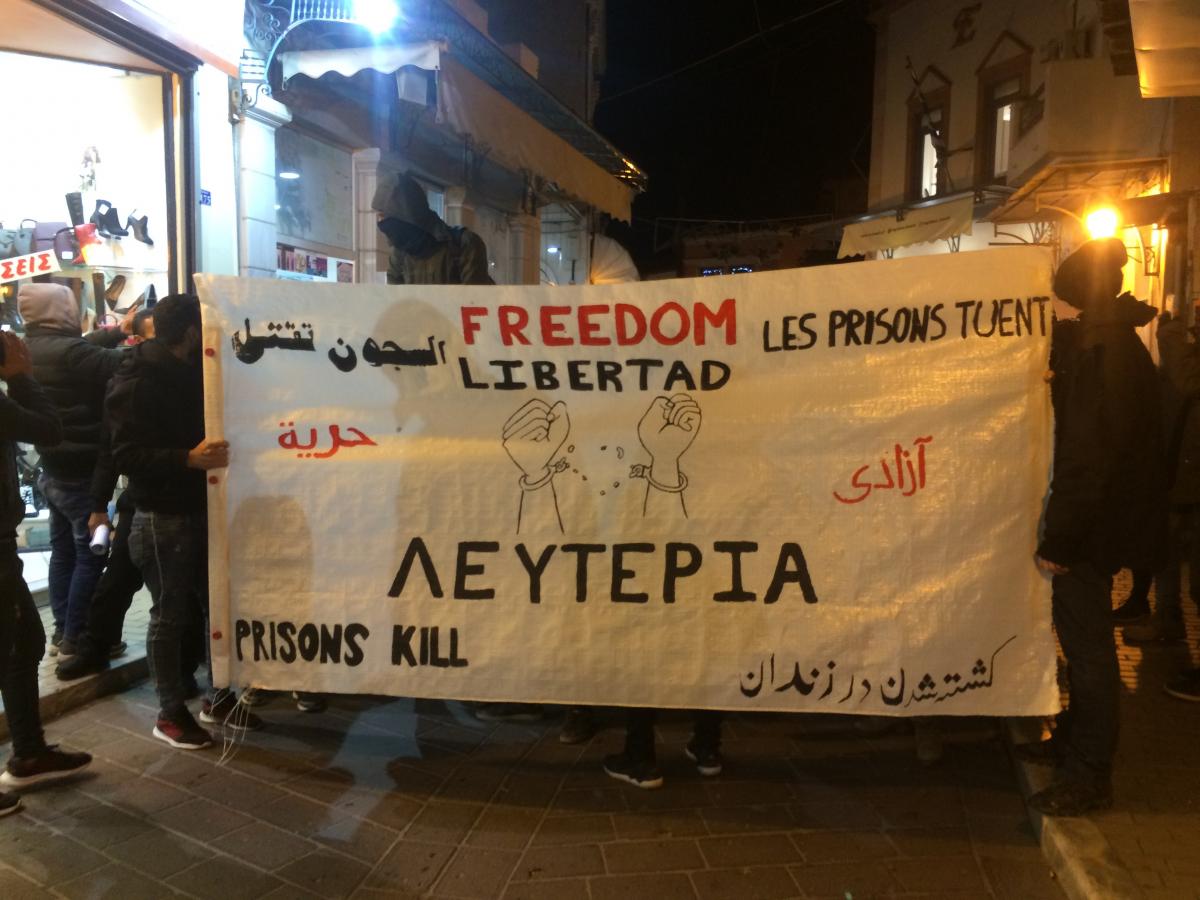Over 30 years of anarchist writing from Ireland listed under hundreds of topics
Movement of Freedom - An overview of the current situation in Lesvos
Tensions have been growing amongst the migrant communities in Lesvos since the beginning of January when the new right-wing government (New Democracy) implemented more aggressive migration policies with a view to “decongest” the Aegean islands and to stem the flow of migration. Deputy minister Stelios Petsas announced that “the government, from the first moment, followed a different policy on the refugee-migration issue. With a comprehensive plan based on four axes: guarding the borders, speeding up asylum procedures, increased returns and closed pre-departure centers.” What this translates to is increased spending on border controls, a staggering backlog of asylum claims, fast-track border procedures that fail to protect people (including children) from deportation if they are rejected in the first instance, even if they appeal, along with large scale confinement and detention.
People protest against the Pre-Removal Detention Centre in Moria Camp after an Iranian migrant was found dead, hung in his cell.
Soon after their election, New Democracy disbanded the Ministry of Migration and Asylum (in Greece of all countries) and so far the impact of their harsh migration policies and the deteriorating situation on the islands has had fatal consequences. On 7th July 2019, when New Democracy was elected into office, 5,685 people were residing in Moria camp with a total capacity of 3,100. As of the 5th January 2020 that number has reached a staggering 19,467 residents with a decrease in capacity to 2,840. In August 2019 a fifteen-year-old unaccompanied minor was killed in the “safe zone” of Moria camp by another unaccompanied minor. In September 2019 a woman and a child in Moria camp died in a fire that broke out in their container, and in December 2019 a woman in Kara-Tepe (a smaller state-run camp 5km from Moria camp) died after a heating device caught fire in her container. On 6th January 2020 an Iranian migrant was found dead, hung in his cell, in the Pre-Removal Detention Centre of Moria after he was detained for two weeks in solitary confinement without access to medical or psychological support. Since his death there have been three more reported suicide attempts in the detention facility. Due to the harsh circumstances in the camp where people are forced to live without any protection, violence and exploitation escalate, and criminal structures develop. As such, on 1st January, a 20-year-old man from Congo was stabbed with a knife after he refused to hand over his mobile phone to a small gang. While his two friends were injured in the same incident, he died in hospital two weeks later. On 16th January, a 20-year-old Somali-Yemeni man was violently stabbed to death during a similar incident. On 20th January, an 18-year-old woman was stabbed with a knife and is still in a critical condition in hospital. These deaths, along with the complete lack of protection from the negligent Greek state, the rapidly declining conditions in the camps, and increasingly restrictive migration policies have directly resulted in the recent protests on Lesvos and have sparked a new liberation movement among the migrant communities.
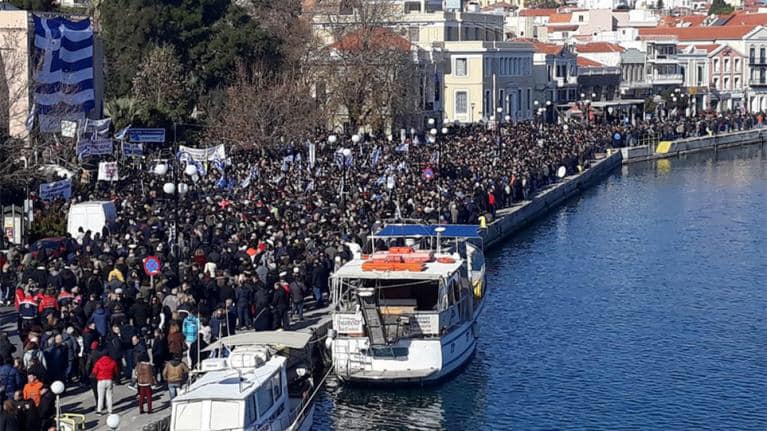
General strike outside the Municipal Theatre in Lesvos in protest of the new Greek Governments migration policies.
On 22nd January the right-wing municipal party ‘Free Citizens’ called a general strike on the Greek islands of Lesvos, Chios, and Samos to protest against the Greek government’s migration policy. In Lesvos approximately 9,000 locals gathered outside the Municipal theatre, which had been draped with a Greek flag alongside a banner reading “Lesvos is Greek.” While the call out appeared moderately center-right with slogans proclaiming “We want our Islands back. We want our lives back”, the underlying tone of the rally was nationalist, racist and xenophobic. The populist rhetoric behind decongesting the islands is a strategic and vain attempt to show sympathy for the people living in the squalid conditions in the camp, whereas in reality it is grounded in anti-immigrant sentiment and is far more violent. This was clearly demonstrated as people exclaimed that they will throw the migrants back into the sea and shouted “Paki go home” at passing migrants.
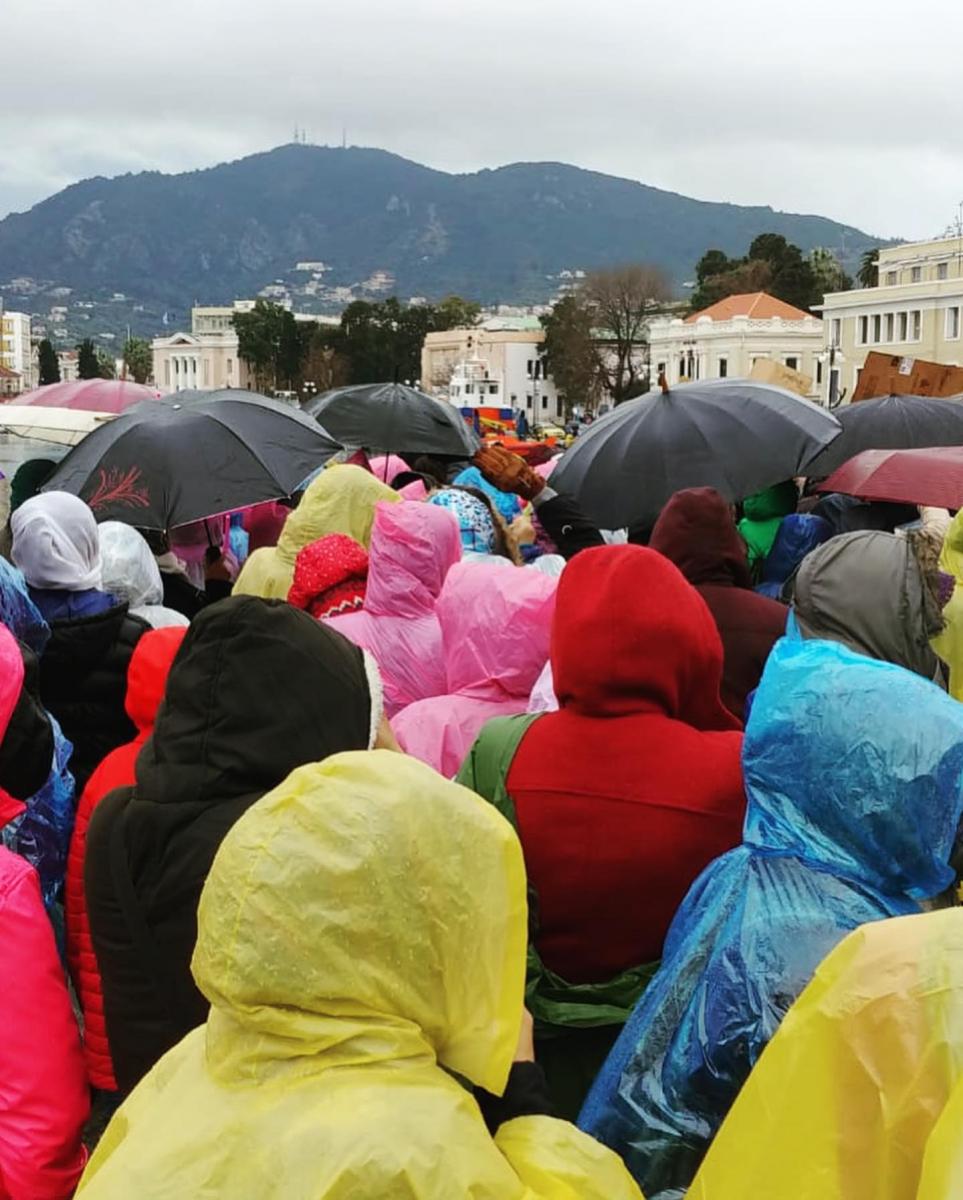
300 Afghan women march to the Municipal Theatre in Mytilini
The following Thursday, 30th January, in imitation of the general strike, approximately 300 Afghan women marched to the Municipal theatre to protest the inhumane conditions in Moria camp, to speed up the asylum process, and to demand a lift of their geographical restriction in order to move to the mainland. In peaceful protest they blocked the road in front of the theatre for a short time but were soon surrounded and restricted by riot police. During this time approximately 9 migrants and solidarians were brought to the police station where they were detained for a short time, questioned, and had their ID’s checked. The protest soon dispersed and some women gathered in a nearby squat to regroup. However, the connection between the squat and the migrant movement was broadcast on local media who speculated over the involvement of the “radical-left” in the demonstration. They went as far as questioning who wrote the banners for the women, as if all migrants are illiterate and can’t organise themselves.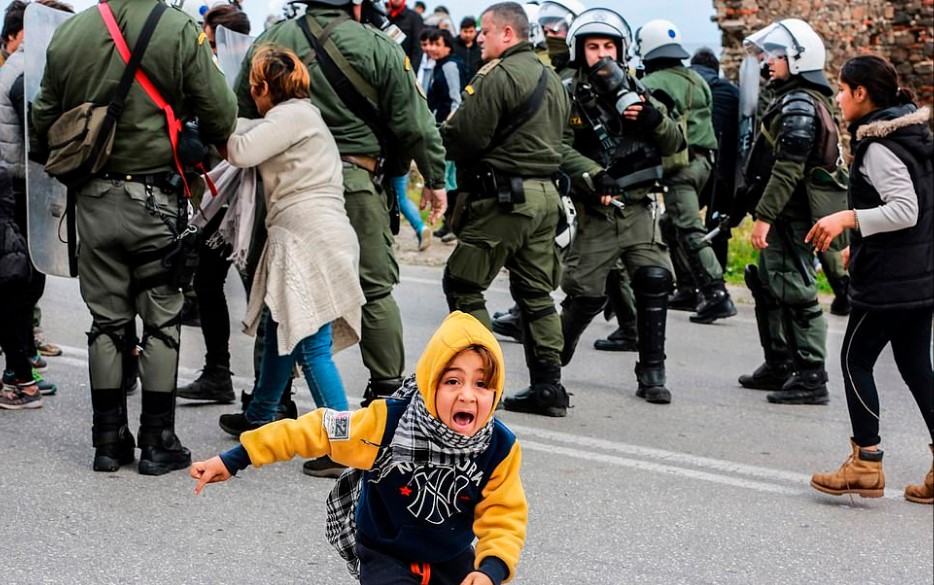
A child runs from riot police as they violently escalate the situation.
On Sunday 2nd Feb, two more riot police units were brought to Lesvos to somehow control the spiralling situation. On Monday morning, 3rd February, a group of approximately 2,000 men, women, and children from the Afghan community began the 8km march towards Mytilini to demand their freedom. Upon reaching Kara-Tepe camp they were confronted by riot police who had formed a blockade to prevent the demonstration from reaching Mytilini. As tensions flared the riot police violently beat back the protestors and fired teargas to disperse the crowd. The protestors defended their position and their community as best as possible but after many injuries, arrests, and a heavy use of force by the police, they fled the scene into the nearby fields and back down the road where they returned to Moria camp.
Simultaneously, a small group of approximately 200 people escaped through the fields towards Mytilini and blocked the road outside the Municipal Theatre. The protest remained peaceful and they held their position without incident. Throughout this time they were surrounded by riot police on three sides as the sea served as a natural barrier at their back. As the riot police encroached further into their space, essentially pushing them towards the sea, a coast guard vessel docked nearby and two SAR RIBs were sent out to patrol the area. In Lesvos there is a special branch of motorbike police who come from Athens and they are well known for being more aggressive and militant than the regular police. They were dispatched to control and push back the solidarians who were present at the theatre to show support and monitor the situation. Between the two protests this day, approximately 21 migrants and solidarians were brought to the police station where they were detained for a short time, questioned, and had their ID’s checked.
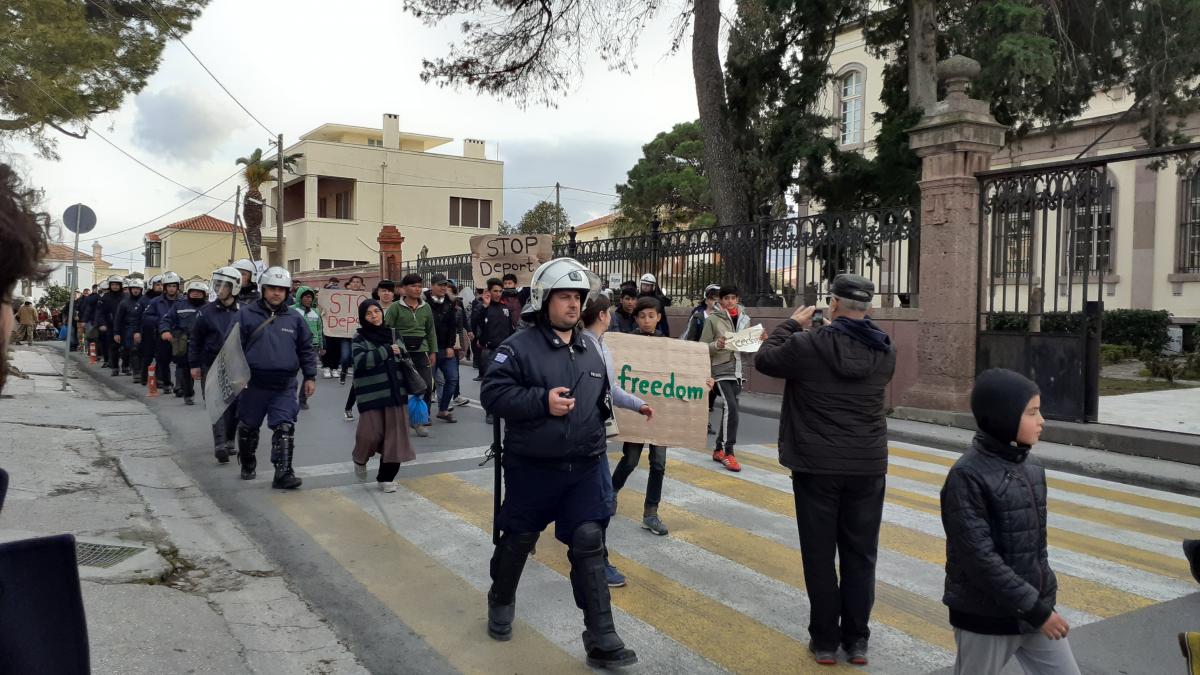
The protesters are escorted out of Mytilini by an excessive number of riot police.
After approximately four hours and some negotiation attempts, the protestors agreed to walk back to Moria camp. A large contingent of police, motorcycle police, riot police, and secret police escorted the protestors out of Mytilini in the direction of Moria Camp. Another riot police unit was dispatched to protect government offices as the march passed by. After the protestors passed Kara-Tepe camp, the riot police held back and the march proceeded without them. As the protesters neared Moria village (1km outside Moria camp) the residents of the village erupted in protest and refused to let the group pass through. The situation grew tense as the protesters compressed into the narrow street leading into the village and the motorcycle police wielded their batons as they tried to pass through the crowd. Some of the locals threw empty plastic bottles at the crowd and the church bells rang to sound an alarm. The police intervened to separate the two groups and ultimately forced the protesters to turn around. They circumnavigated the village and made their way to Moria camp without incident. The group paraded through the camp in a victory march and to express solidarity to their comrades who had been beaten down and repressed by the police earlier that day. As they exited the other side of the camp to return to the main gate some individuals at the gate tipped three large wheelie bins over in order to block the road. Upon this potential display of escalation the camp police and riot police rapidly mobilised and suppressed all further action.
The situation for the migrant communities living in the camp has become so desperate that many fall through the cracks and are left without food, shelter, medical support, and cash assistance. As a result they are forced to forage for food, building materials, and other resources in order to survive. Consequently, Moria village has been victim to a string of thefts and break-ins due to its proximity to the camp. This, along with the ever increasing number of arrivals, the spread of misinformation, and New Democracy’s failure to manage the situation, has created a recipe for hatred, racism, and fear to fester within the local population.
Soon after the protesters tried to pass through Moria village, the residents held a meeting with the mayor of Mytilini to express their anger and frustration over the spiralling situation and to condemn the NGO’s who are perceived to be in cahoots with the migrant communities and for profiteering from this “crisis.” They demanded to decongest the islands and for full-time police presence in the village for their own protection. That night they formed a blockade on the road going into the village to prevent migrants from entering and smashed the windows of an NGO house. The police set up a check-point outside the village, presumably to prevent migrants from reaching the village and to prevent further violence.
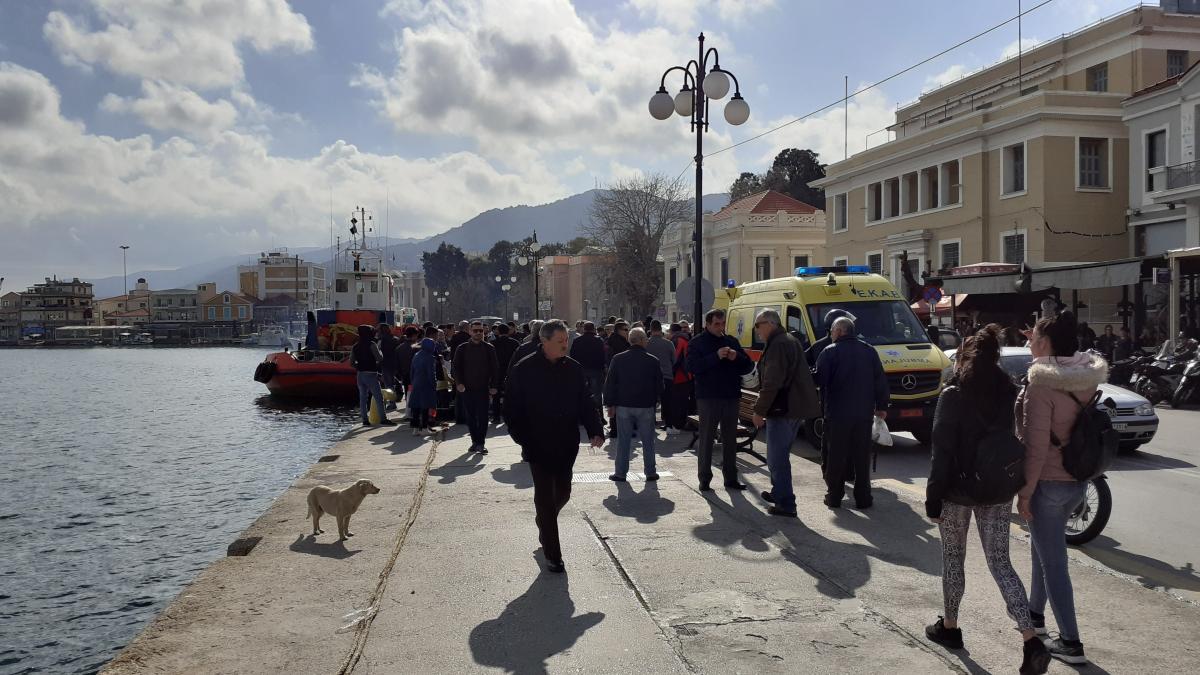
Afghan woman is left unconscious on the side of the road after violent police suppression
The following morning, Thursday 4th February, approximately 100 people from the Afghan community marched once again to the Municipal Theatre in Mytilini and attempted to block the road. They were met by a small gang of far-right locals and were violently confronted by the riot police who beat and chased them away. The far-right gang chased some of the migrants through the streets but it seems they failed to confront them. Several people escaped the riot police with minor injuries, except for one woman who lay unconscious on the side of the road after. As some migrants and solidarians gathered to attend to the woman, an older Greek man tried to beat and chase a young Greek woman who was with the group. He implied that he was concealing a knife in his pocket but quickly fled the scene upon the arrival of an ambulance. Once again, during this demonstration 4 migrants and solidarians were brought to the police station where they were detained for a short time, questioned, and had their ID’s checked.
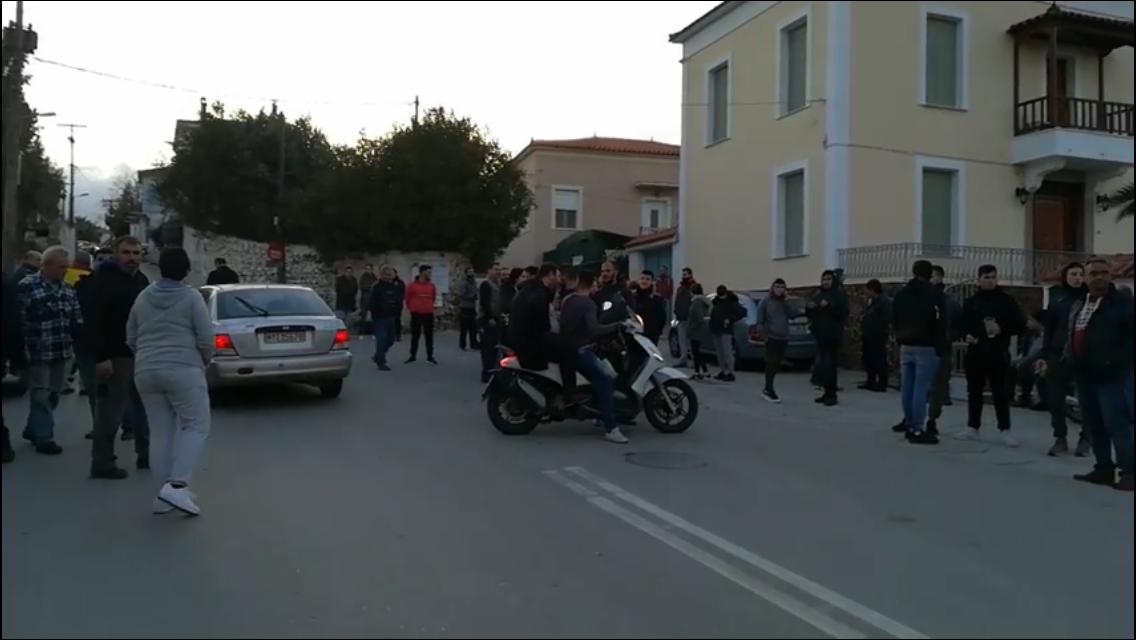
The residents of Moria Village set up a blockade on the way into the village.
That night, approximately 40 locals in Moria village gathered to instigate a pogrom against the migrant community and those in solidarity with them. They smashed the windows of an NGO car as it drove though the village towards Moria camp, carrying two migrants in the back. They attacked a resident from the village who expressed opposition to the pogrom and they beat a migrant who managed to walk past the police check-point without being warned of what lay ahead. Subsequently his head was “broken” and an ambulance was called.
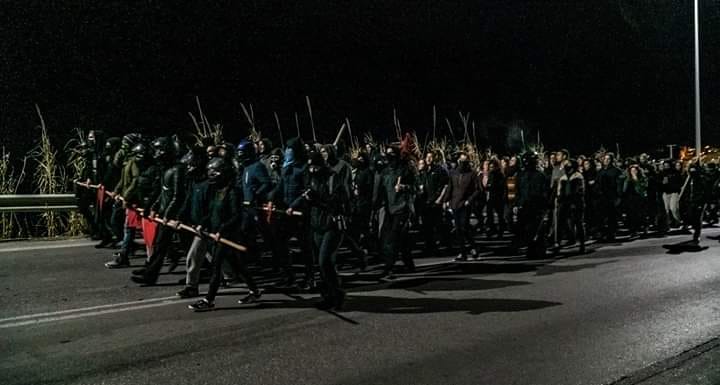 Approximately 120 antifascists march towards Moria Village.
Approximately 120 antifascists march towards Moria Village.
Late that night a group of approximately 120 antifascists marched from Epano Skala on the outskirts of Mytilini towards Moria village. This action was called in direct response to the violent police repression against the migrant protests and to the pogrom organised by the residents of Moria village. After marching over 2 kilometres, the group reached Kara-Tepe where they stopped to express solidarity to the residents inside the camp by shouting “Azadi Azadi” (“Freedom Freedom”) and as a symbol of defiance against the violence that occurred there at the hands of the police the day before. In a vain attempt to mobilise and confront the antifascists, members of the far-right circulated rumours that the aim of this action was to burn down the Public Power Corporation (PPC) power plant near Kara-Tepe. However, no-one appeared due in part to the heavy police presence.
Riot police blocked the road with an armoured bus several hundred metres beyond Kara-Tepe. With no desire to clash with the police the group turned around and headed back towards Mytilini where they assembled on Sappho Square (the main square of Mytilini and a historic location for the antifascist and migrant liberation movement) to reclaim Mytilini’s public space. In a final symbolic gesture, they marched to the Municipal Theatre and pulled down the banner reading “Lesvos is Greek” which had been left up and tolerated since the municipality strike two weeks prior.
In the following hours after this demonstration, the streets were tense as a small gang of young men roamed around on motorbikes wearing helmets and wielding wooden sticks. It was reported that they were checking people on the street to see if they were migrants or NGO workers. Upon seeing some suspected migrants and NGO workers they chased them into a nearby bar and beat one woman who was sitting outside. They were quickly chased off by a large group of antifascists who were still patrolling the streets. Two days later the police arrested 7 people in Moria village and were searching for two more people on suspicion of planning or carrying out attacks on migrants on the island of Lesvos. On the 10th February, the police announced that they were investigating 14 migrants (13 Afghan and 1 Iranian). The case filed with the Public Prosecutor's Office of Mytilini includes charges of inciting violence, disturbing the peace, destruction of property, attempt to cause grievous bodily harm, disorderly conduct, and violation of gun legislation.
An ideological war has been waged on the political left since New Democracy was elected into power. It started with the violent squat evictions in Exarcheia, the militant repression of the antifascist movement, further militarisation of the borders, increased detention and deportations (with promises to deport 10,000 people in 2020), restricted access to safeguards for asylum seekers, scepticism and suspicion of NGO workers, and it has directly resulted in the confinement of more than 42,080 migrants on the Aegean Islands. With the recent events in Lesvos, we are witnessing the normalisation of a violent fascist ideology along with systematic oppression and criminalisation of migration, brutal suppression of resistance movements, and a ham fisted and pigheaded approach to dealing with migration in Greece.


